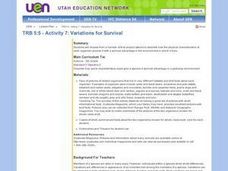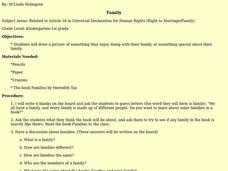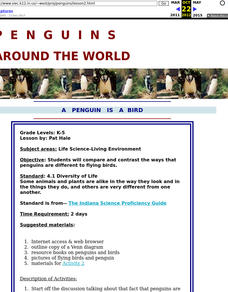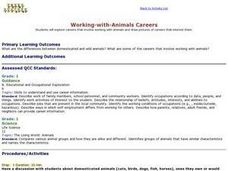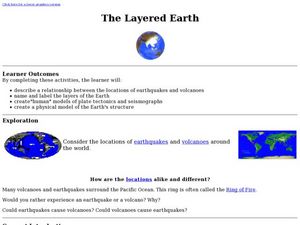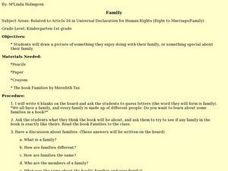Curated OER
Homophones Activities 1-5
In this language arts worksheet, students discover that homophones are words that sound alike. Students complete 5 activities with homophones: matching words to pictures, completing sentences, explaining differences between words and...
Curated OER
Variations for Survival
Fifth graders examine two related organisms that live in different environments and compare how the physical characteristics of each organism provided it with survival advantages unique to its own environment.
Curated OER
Where People Work
Students investigate where people work. In this social studies lesson, students use a Landscape Picture to locate places of work. Students discuss how each job is similar and different.
Curated OER
Animals and Animal Babies
Students examine how some animal young are similar to the adult. They look at pictures of various animals and their young and identify if they look similar or not similar to the adult animal, and draw a picture of a baby and parent...
Curated OER
IDENTIFYING AND SORTING BEARS
Students study the difference between living and nonliving bears by classifying pictures of bears and placing them on the appropriate posterboard. Given pictures of bears, students recognize types of bears by placing the pictures correctly.
Curated OER
Family
Students listen to a teacher read aloud of a book about families before discussing what a family is to them. They discuss how families can be the same or different, who they are made of, and what their traditions might be. They draw a...
Curated OER
How Does a Seed Grow Into a Plant?
Second graders explore how seeds grow into plants. They discuss types of seeds and place seeds in wet paper towels to germinate. They draw a picture in their journal to record their observations for four days. They take pictures of their...
Curated OER
States of Matter
First graders experiment with different states of matter in order to observe the changes in matter. In this states of matter lesson plan, 1st graders see and explain how solids, liquids, and gases change.
Curated OER
A Penguin is a Bird
Students compare and contrast the ways that penguins are different to flying birds.
Curated OER
I've Seen That Shape Before
Students identify geometric solids. In this shape instructional activity, students explore the characteristics of geometric solids. They locate pictures of shapes on the internet, and identify the shapes. Students draw...
Curated OER
Big Bellies and Dandy Duffs
Students practice tracing and identifying lower-case b and d letters as well as pictures containing examples of those letters. They mimic the sounds that the letters make and offer examples of those sounds rhyming when applicable.
Curated OER
Science-Introduction to Mammals
Young scholars discover mammals. In this mammals lesson, students examine pictures of mammals and their backbones. Young scholars also feel the backbone of a guinea pig.
Curated OER
Can rice plants talk?
First graders compare and contrast rice plants with people. In this rice plant lesson plan, 1st graders discuss what make rice plants similar to people such as their bodies and coverings. They also discuss how they are different in what...
Curated OER
People-Growing and Changing
Second graders study how people grow and change. In this health lesson, 2nd graders describe how they have changed over the years and guess who each student is after looking at everyone's baby pictures.
Curated OER
Memory Game
Students interact with different explorers and their motivations for exploration. They make a deck of memory cards. Students use 20 specific motivational factors in making their cards. They then play their game.
Curated OER
Tangrams
Fifth graders explore the context of how and when to use tangrams in geometry. They create and draw a number of different geometric figures using tangrams. Students work on their visual spatial skills.
Curated OER
Big Cat Classification
First graders discover the different names and classifications of big cats by using word processing applications. In this animal life lesson, 1st graders investigate one big cat and create a database of facts about it using an word...
Curated OER
Figurative Language: Metaphors and Similes
Fifth graders are introduced to the figurative language using metaphors and similies. They identify the similarities and differences between the two and practice developing their own to use in their writing. They illustrate their...
Curated OER
Working-with-Animals Careers
First graders list and discuss careers that involve working with animals and draw pictures of careers that interest them. They compare and contrast domestic and wild animals.
Curated OER
Shapes are Everywhere
Second graders gain an understanding of geometric shapes and spatial reasoning. They learn the attributes of solid shapes in everyday activities. Students compare geometric shapes to everday objects, finding things that serve a purpose...
Curated OER
The Layered Earth
Students role play plate tectonics by creating a "plate statue" made up of students. In this earth science lesson, students describe how Earth's movement cause earthquakes and volcanoes. They draw and name the different layers of the Earth.
Curated OER
The Plant and Animal Walk
Students draw pictures and write words to describe objects and experiences. They observe outside and draw at least three animals and three plants. Students observe plants and animals describing how they are alike and how they are...
Curated OER
Family
Students draw a picture of something they enjoy doing with their family, or something special about their family. Students share their pictures with the class, and then they will be displayed in the classroom.
Curated OER
Tracks are for Trains
Second graders collect data on different forms of transportation and create a bar graph or pictograph with the information.



